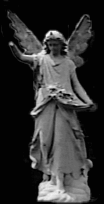More Christmas Traditions

Candy Canes
The candy cane is a symbol of the humble roots of Christianity, the shepherd's crook. Legend has it that in 1670, the choirmaster at the Cologne Cathedral in Massachusetts handed out plain white sugar sticks among his young singers to keep them quiet during the long Living Crèche ceremony. In honor of the occasion, he had the candies bent into shepherds' crooks. Since then, more Christian symbolism has been attributed to these Christmas candies.
The hardness of the candy cane reminds Christians that the church was founded on solid rock.
The traditional peppermint flavor of the cane is tastes like hyssop, a plant in the mint family. It was used in the Old Testament for purification and sacrifice.
Records show that some people gave candy canes to children who learned their prayers. The shape of the candy cane, like a 'J', signifies Jesus.
In 1847, a German-Swedish immigrant named August Imgard of Wooster, Ohio, decorated a small blue spruce with paper ornaments and candy canes.
It was not until the 1920's that the candy cane's more recognizable striping was added. It is in this regard that Georgian Bob McCormick, from Albany, even has a place in candy cane history. Bob McCormick ran a small confectioners in Albany, GA, and started by hand-twisting the colors into the candy canes. In the 1950s, Bob’s brother-in-law Gregory Keller, a Catholic priest, invented a machine to automate candy cane production. "Bob's Candies" is now a very common commercial brand of candy cane.
In the now traditional candy cane, Christians have found ways to remind themselves of the true focus of Christmas -- Christ. We are reminded of Christ's blood and His purity by red and white stripes. You may have noticed the different size of the red stripes. The wider red stripe reminds us of the blood that Jesus shed on the cross. The stripes and wounds that he received are symbolized by the smaller red stripes. The white stripes represent Christ's sinless purity. The three stripes together represent the Holy Trinity
 SACRED HEART CHURCH NEW HAVEN, CONNECTICUT
SACRED HEART CHURCH NEW HAVEN, CONNECTICUT













 Official Mascot of The League of Warm & Fuzzy Traditionalists
Official Mascot of The League of Warm & Fuzzy Traditionalists







0 Comments:
Post a Comment
<< Home